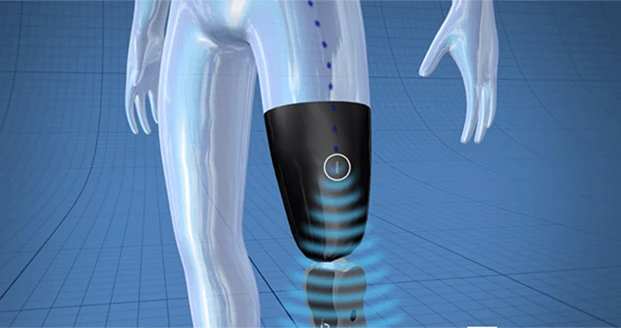
Iceland – Two amputees are the first people in the world able to control their Bionic prosthetic legs with their thoughts, thanks to tiny implanted myoelectric sensors (IMES) that have been surgically placed in their residual muscle tissue. The IMES, which was provided by the Alfred Mann Foundation, instantaneously triggers the desired movement, via a receiver located inside the prosthesis. This process occurs subconsciously, continuously and in real-time.
The announcement was made by Jon Sigurdsson, president & CEO of Össur, the global innovator credited with creating the world’s first Bionic prostheses for amputees.
“Mind-controlled bionic prosthetic legs are a remarkable clinical breakthrough in next-generation bionic technology,” Sigurdsson said, speaking at the company’s Capital Markets Day in Copenhagen. “By adapting not only to the individual’s intentional movements but to intuitive actions, we are closer than ever to creating prosthetics that are truly integrated with their user.”
How mind-controlled bionic prosthetics work
Össur’s commercially available bionic prostheses are smart limbs capable of real-time learning and automatically adjusting to their user’s walking style (gait), speed, and terrain. Walking with a bionic prosthesis, however, still typically requires some conscious, intentional thought from the user.
According to Dr. Thorvaldur Ingvarsson, M.D., Ph.D, the orthopedic surgeon who leads Össur’s research and development efforts and spearheaded the mind-controlled prosthetics project, movement in able-bodied individuals generally begins subconsciously, which triggers electrical impulses inside the body that catalyze the appropriate muscles into action. Össur’s new technology replicates that process in an amputee: that electronic impulse from the brain is received by an IMES that was surgically placed by Dr. Ingvarsson into muscles in the amputee’s residual limb.
“The technology allows the user’s experience with their prosthesis to become more intuitive and integrative,” Dr. Ingvarsson said. “The result is the instantaneous physical movement of the prosthesis however the amputee intended. They no longer need to think about their movements because their unconscious reflexes are automatically converted into myoelectric impulses that control their bionic prosthesis.”
Promising first-in-man results
According to Dr. Ingvarsson, the mind-controlled technology works with all current commercially available Össur bionic prostheses, including the company’s POWER KNEE, RHEO KNEE, PROPRIO FOOT, and SYMBIONIC LEG.
Two amputees have participated in the company’s initial First-in-Man research. Both were implanted with the IMES and have been living with Össur’s mind-controlled bionic prostheses for more than one year. Dr. Ingvarsson notes that feedback from both users has been very positive, and that clinical trials to assess the technology further will continue.
“As a global leader in prosthetics and orthopedics, we at Össur never stop innovating. We are resolute in our commitment to expand the boundaries of possibility, so that we may help even more people enjoy a life without limitations,” Sigurdsson concluded.
Source: Össur
Latest from Today's Medical Developments
- Arcline to sell Medical Manufacturing Technologies to Perimeter Solutions
- Decline in German machine tool orders bottoming out
- Analysis, trends, and forecasts for the future of additive manufacturing
- BlueForge Alliance Webinar Series Part III: Integrate Nationally, Catalyze Locally
- Robot orders accelerate in Q3
- Pro Shrink TubeChiller makes shrink-fit tool holding safer, easier
- Revolutionizing biocompatibility: The role of amnion in next-generation medical devices
- #56 Lunch + Learn Podcast with Techman Robot + AMET Inc.





